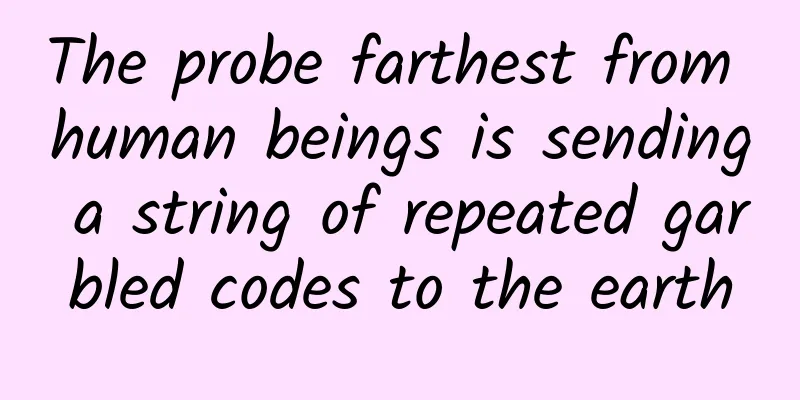The probe farthest from human beings is sending a string of repeated garbled codes to the earth

|
101011100110000 111010000000011 1111111100001100 101000110001101 1000100111000001 11000000000010 On December 12, 2023, NASA announced that one of the three onboard computers of the Voyager 1 probe, the Flight Data System (FDS), had malfunctioned and began to repeatedly transmit a specific combination of 1 and 0 garbled codes to the Earth , as if it was "stuck." Concept map of Voyager 1 (Image source: NASA) The FDS is used to collect data from scientific instruments and engineering data about the status of Voyager 1, which are packaged and then sent back to Earth in binary form of 1s and 0s by a subsystem of the FDS, the Telemetry Modulation Unit (TMU). Currently, Voyager 1 can still receive and execute commands from Earth, but cannot return scientific and engineering data to Earth. After the failure, the Voyager team has tried to restart and restore to the state before the failure, but Voyager 1 still failed to return data normally. Instruments on Voyager (Image credit: NASA) Since Voyager 1 was launched in 1977, engineers need to carefully read documents left over from decades ago to develop plans . They need to determine how the instructions of the new launch will affect the operation of Voyager 1 to avoid unexpected consequences. Moreover, Voyager 1 is currently more than 24 billion kilometers away from Earth, and it takes 22.5 hours for commands sent from Earth to arrive . This means that the engineering team must wait 45 hours to receive a response from Voyager 1 to determine whether the command was successfully executed. The engineering team said it may take several weeks to find a solution. Everything starts with the "Four Stars Linked Together" In 1965, Gary Flandro, a doctoral student in aeronautics at the California Institute of Technology and working part-time at NASA's Jet Propulsion Laboratory (JPL), discovered that Jupiter, Saturn, Uranus, and Neptune would form a long arc with the Earth in the late 1970s and early 1980s. This coincidence means that the spacecraft can get a speed boost from the gravity of each giant planet when passing by it. Flandro calculated that this repeated gravity boost can reduce the flight time of the probe between Earth and Neptune from 30 years to 12 years . This planetary conjunction only occurs once every 176 years, so we must seize the opportunity. To take advantage of this once-in-a-century opportunity, NASA designed two identical spacecraft, Voyager 1 and Voyager 2, and launched them within 15 days of each other in the summer of 1977. Prior to this, only one spacecraft, Mariner 10, had used gravity assists to reach another planet. The Voyagers not only needed multiple gravity assists, but also needed to control the error range within tens of minutes, which shows how difficult it was. Mariner 10 (Image source: NASA) To meet these challenges, NASA engineers equipped Voyager's computer with 69 kilobytes of memory . "The memory in the Voyager computer is smaller than the memory in your car key fob," said Linda Spilker, a planetary scientist at JPL. To have enough memory to take new images, Voyager must delete the old data each time it is sent to Earth. The data is stored on an eight-track magnetic tape storage device inside the Voyagers and sent back to Earth by a 23-watt transmitter , which is about the power of a refrigerator light bulb. To make up for the lack of transmitter power, both Voyagers carry a dish antenna about 12 feet wide to send and receive signals. Great Journey Voyager 1 arrived at Jupiter in March 1979, 546 days after launch. Voyager 2 followed a different trajectory and arrived in July of the same year. They carry light-guided cameras that use red, green, and blue filters to take full-color images. When Voyager was about 3-4 months away from Jupiter, they sent back the first photo of Jupiter. In the photo, Jupiter's third largest satellite, Io, appeared orange and black, which was completely unexpected . Scientists have always believed that all satellites in the solar system are monotonous in color and bumpy, but Voyager led everyone to witness the colorful satellite landscape around Jupiter and Saturn. Image of Io taken by Voyager 1 (Image credit: NASA) Voyager has taken more than 33,000 photos of Jupiter and its satellites . Through these photos, scientists have discovered that Io has active volcanoes, and the level of volcanic activity is 10 times that of the Earth, and the jet height of its largest volcano is 30 times that of Mount Everest; Europa is covered by a cracked ice shell, which is about 100 kilometers thick. Near Saturn, the two Voyagers parted ways. Voyager 1 zoomed through Saturn's rings, flew past Titan, and then exited the solar system's planetary plane, while Voyager 2 continued on its own toward Uranus and Neptune. Voyager 1 took one last set of images before entering interstellar space in the Milky Way. Voyager 1 pointed its camera at the inner solar system on Valentine's Day 1990, snapping these final 60 images. The most memorable is what astronomer Carl Sagan called the " Pale Blue Dot ," the most distant portrait of Earth ever taken (more than 6.1 billion kilometers). Earth is barely visible in the image, not even occupying a single full pixel, because the strong sunlight reflected off the camera's optics obscures the image. "Pale Blue Dot" (Image credit: NASA) Flying into interstellar space Every day, Voyager will travel another 3 to 4 light seconds. The only link between Voyager and Earth is NASA's Deep Space Network, a network of three tracking complexes around the world that communicate with the spacecraft continuously as the Earth rotates. As the Voyagers move farther away from us in space and time, their signals are getting weaker. Earth is a noisy place, with noise from TVs, cell phones, etc. So it's getting harder and harder to pick up the Voyager signals . Even though these signals are incredibly weak, they've led to discoveries far beyond astronomers' expectations. In 1993, physicist Donald Gurnett calculated that the distance to the heliosphere should be 116-117 astronomical units (AU, 1AU refers to the average distance from the earth to the sun, equivalent to 150 million kilometers), but his peers did not agree. The ground team has been waiting for Voyager to reach the heliosphere and detect the interstellar magnetic field that is different from the direction of the heliosphere magnetic field. Voyager and the heliosphere (Image credit: NASA) On August 25, 2012, Voyager 1 finally crossed the heliopause, a distance that was roughly consistent with Gurnett's estimate. It also detected the expected plasma density jump, but did not detect a change in the direction of the surrounding magnetic field . In November 2018, when Voyager 2 arrived at the interstellar edge, it also failed to detect such a change, and the time of its arrival did not match the predictions of any theoretical model. All of these instruments are powered by the same unit that converts heat from the radioactive decay of plutonium into electricity. With output decreasing by 4 watts per year, NASA has been forced to go into a shunt mode. A few years ago, engineers turned off the heaters for the cosmic ray detectors on the Voyagers. "Voyager" timeline (Image source: NASA) Even if one day in the future, Voyager 1 is completely silent, its journey will continue. In 16,700 years, it will pass by the nearest star to us, Proxima Centauri . After that, it will continue to orbit the Milky Way for millions of years. Even if the sun and the earth no longer exist, it will still be traveling in the Milky Way. Perhaps, at some point in the future, non-human creatures in the stars will receive the last message from Voyager, the "Golden Record" . They will learn from the "Golden Record" where Voyager came from, the creatures, landscapes, sounds and culture on Earth, and a message from former US President Jimmy Carter: "Golden Record" (Image source: NASA) References [1]https://blogs.nasa.gov/sunspot/2023/12/12/engineers-working-to-resolve-issue-with-voyager-1-computer/ [2]https://www.smithsonianmag.com/smart-news/nasas-voyager-1-is-glitching-sending-nonsense-from-interstellar-space-180983448/ [3]https://www.nasa.gov/missions/voyager-program/voyager-2/engineers-solve-data-glitch-on-nasas-voyager-1/ [4]https://edition.cnn.com/2023/12/13/world/voyager-1-computer-issue-scn/index.html [5] Global Science, August 2022: “Voyager: The Final Farewell” Planning and production Source: Global Science (id: huanqiukexue) Written by Huang Yujia Editor: Wang Mengru |
<<: The new coronavirus JN.1 variant is coming? This little thing must be done well
>>: Are your eyes also afraid of the cold? Be careful of these eye diseases caused by "freezing"
Recommend
2020 GDP rankings of 31 provinces in China announced: Beijing, Shanghai and Guangzhou will face economic challenges
As of July 28, 31 provinces, cities and districts...
How to promote on Momo?
Momo is a mobile social application based on loca...
Price inquiry for the development of Kashgar Fresh Food Mini Program. How much does it cost to produce the Kashgar Fresh Food Mini Program?
How much does it cost to join a fresh food mini p...
Advertising case in wedding photography industry!
During the epidemic, the wedding photography indu...
How to name a brand, here are 6 tips!
Written at the beginning: The success of big bran...
All the gameplay routines of using blind boxes to create fission are here!
Everyone knows that blind boxes have been very po...
50 essential proposal writing skills for planners in 2020
During my time as Party B, I wrote hundreds of pr...
How to use ROI data to increase downloads and purchase conversions?
In the first half, traffic acquisition is used to...
You can also make 500,000 yuan a month by relying on information flow!
Before we start today's topic, let's look...
4 strategies for brands to gain traffic from Xiaohongshu (ideas)
With the end of the Spring Festival, the topic of...
Huawei's 5G phones are back, but supply may be limited
The Kirin 9000 chip used in the P50 Pro previousl...
Faced with 530 million yuan in investor claims, can Guoan still remove the ST label?
30 years ago, the famous Beijing Guoan Football C...
Are developers being forced to retreat by the difficulty of monetization? Does the WeChat Mini Program bonus still exist?
In recent months, fewer and fewer development tea...
Analysis of the advantages of car body advertising!
China's large population determines the absol...









